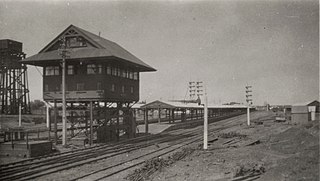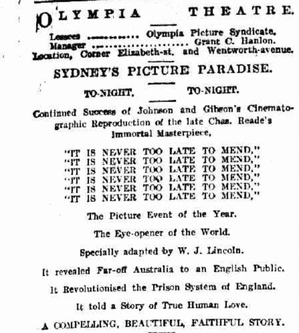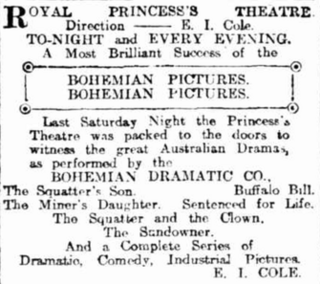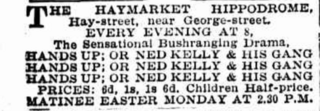
William Joseph Lincoln was an Australian playwright, theatre manager, film director and screenwriter in the silent era. He produced, directed and/or wrote 23 films between 1911 and 1916.

John F. Gavin was a pioneer Australian film actor and director, one of the early filmmakers of the 1910s. He is best known for making films about bushrangers such as Captain Thunderbolt, Captain Moonlite, Ben Hall and Frank Gardiner. Known informally as 'Jack', Gavin worked in collaboration with his wife Agnes, who scripted many of his films.

Kalgoorlie railway station is the easternmost attended station in Western Australia, located at the eastern terminus of the Eastern Goldfields Railway. It serves the city of Kalgoorlie. Beyond Kalgoorlie, the line continues east as the Trans-Australian Railway.
Bardoc is an abandoned town in the Goldfields-Esperance region of Western Australia. It is situated between Kalgoorlie and Menzies along the Goldfields Highway.
Ben Hall and his Gang is a 1911 Australian film about the bushranger Ben Hall, played by John Gavin, who also directed. It is considered a lost film.

Alfred Rolfe, real name Alfred Roker, was an Australian stage and film director and actor, best known for being the son-in-law of the celebrated actor-manager Alfred Dampier, with whom he appeared frequently on stage, and for his prolific output as a director during Australia's silent era, including Captain Midnight, the Bush King (1911), Captain Starlight, or Gentleman of the Road (1911) and The Hero of the Dardanelles (1915). Only one of his films as director survives today.

It Is Never Too Late to Mend is a 1911 Australian feature-length silent film written and directed by W. J. Lincoln.
The Life of Rufus Dawes is a 1911 Australian silent film based on Alfred Dampier's stage adaptation of the 1874 novel For the Term of His Natural Life produced by Charles Cozens Spencer.
The Cup Winner is a 1911 Australian silent film directed by Alfred Rolfe. It is set against a backdrop of horseracing and the finale involves real footage from the 1911 Melbourne Cup.

Bushranger's Ransom, or A Ride for Life was an Australian silent film produced by Pathé Frères' in 1911, their first motion picture production in Australia after establishing a branch office in Sydney in April 1910. It was adapted from a stage play first performed in 1907 by E. I. Cole's Bohemian Dramatic Company.

The Squatter's Son is an Australian film completed in 1911 and directed by E. I. Cole. It was based on a play which Cole and his company had performed throughout Australia.

Sentenced for Life is an Australian film directed by E. I. Cole. It was an adaptation of a play performed by Cole and his Bohemian Dramatic Company as early as 1904.

The Sundowner is an Australian film shot in Victoria. Set in the Australian bush, it was billed as "a romance with many startling adventures".

Dan Morgan is a 1911 Australian film from Charles Cozens Spencer about the bushranger Daniel Morgan. It was said to be starring "Alfred Rolfe and company". Rolfe directed three movies for Spencer, all starring himself and his wife Lily Dampier so there is a chance he may have directed this one and that it starred his wife. A prospectus for the Australian Photo Play Company said he directed it. It is considered a lost film.

Edward Irham Cole was an Australian theatrical entrepreneur and film director whose productions represented a synthesis of Wild West show and stage melodrama. He managed a theatre company, called the Bohemian Dramatic Company, that performed in semi-permanent and temporary tent theatres. During 1910 and 1911 Cole directed a number of silent films, adapted from his stage plays and using actors from his theatre company.

The Squatter and the Clown is a 1911 Australian silent film. It was one of a series of films made by Edward Irham Cole's Bohemian Dramatic Company.
The King of the Road is a 1900 Australian play performed by Edward Irham Cole performed by Cole's Bohemian Drama Company about the bushranger Ben Hall.

Hands Up, or Ned Kelly and His Gang is a 1900 Australian play by Edward Irham Cole about Ned Kelly.
Captain Moonlite, the Wantabadgery Bushranger is a 1906 Australian play about the bushranger Captain Moonlite that was first produced by Edward Irham Cole's Bohemian Dramatic Company.
For King and Empire is a 1906 Australian play by Edward Irham Cole although several scenes and incidents were suggested by Edward William O'Sullivan.













